Background
Many gene therapies are in development for treating genetic diseases, cancers, and other diseases. As of March 2020, more than 4310 gene therapy clinical trials have been performed worldwide, with only 518 of them in phase III and phase IV (1). As the gene therapy projects enter clinical phase III or get approval into the market, large-scale production of viruses has become a limiting factor in the industrialization of gene therapy.
Static systems remain the most widely used systems to produce adeno-associated virus (AAV) and other viruses using HEK293 cell transfection. Cell Factory™ systems can be scaled by adding culture or production units; however, the gas exchange between each plate layer and the culture medium layer is not consistent. Microscopic observation of cell growth is also extremely difficult, and this significantly increases labor intensity, production costs, and contamination risks (2).
Suspension culture is the usual and convenient way for industrialization. However, the quality and yield of the target products will be greatly affected by the essential differences in culture process between adherent cells and suspended cells, such as cell morphology, metabolism, growth behavior, etc. Therefore, it has become increasingly important to establish a large-scale HEK293T cell culture process for virus production (3, 4).
Microcarriers are 60 to 250 micron support matrices allowing for the growth of adherent cells in a suspension system. Microcarriers can be made from various materials including glucan, glass, and other synthetic polymers. These microcarrier materials provide a large cell culture surface resulting in a high surface area to volume ratio. For example, 5 mg Cytodex offers a surface area of 30 cm2. This means that a 50 L bioreactor with 3 g/L Cytodex provides an equivalent surface area to 94 10-layer cell factories with cells grown in monolayers. Microcarrier culture, which combines the advantages of adherent and suspension culture, enables the suspension culture of cells in adherent state. Further, it can produce large quantities of cells without the need for large-capacity equipment. Microcarrier culture can be performed in scalable single-use bioreactors, which reduces labor demand and the risk of contamination (5).
Scientists at Obio Technology have successfully adapted an adherent HEK293 cell line to grow in animal component-free and serum-free suspension conditions in shaker flasks. After comparing adherent, suspension, and microcarrier culture for AAV production, they believe that microcarrier culture is suitable for large-scale production of viral vectors to support future gene therapy manufacturing processes.
Materials and methods
Microcarrier preparation
Cytodex 1 microcarriers were hydrated and sterilized according to the manufacturer’s instructions. An appropriate amount of dry Cytodex 1 microcarriers was hydrated in D-PBS at 50 mL/g Cytodex 1. Hydrated microcarriers were washed once using the same volume of D-PBS, and then autoclaved at 121°C for 60 min. The supernatant was removed, and microcarriers were washed with the same volume of D-PBS. After the microcarriers sedimented, the supernatant was removed. For each gram of microcarriers, 50 mL DMEM containing 10% FBS was added followed by incubation at 37℃ for 4 h before use.
Cell preparation
Adherent cells were prepared by quickly thawing a frozen vial of HEK293T in a 37°C water bath. Following centrifugation, the supernatant was discarded and the pellet resuspended with medium and transferred to a T-75 flask. When the culture became confluent after 2 days of growth, cells were detached with a recombinant enzyme for cell dissociation following a D-PBS wash. Then the T-75 flask was placed at room temperature for approximately 2 min. A subculture ratio of 1:4 to 1:6 was most often applied with these cell lines in the T-flask expansion process.
Suspension cells were prepared from HEK293T cells that were simultaneously adapted to suspension growth and a chemically defined animal component-free medium using a multistep method, progressively increasing the percentage of medium and decreasing the serum concentration. The resulting HEK293T cells were grown in the serum-free medium in shake flasks.
Cell cultures
For microcarrier cultures, the appropriate quantity of prepared Cytodex 1 was inoculated with HEK293T cells at 4 × 105 cells/mL in a spinner flask with 125 mL medium. Final Cytodex 1 concentration was 3 g/L.
For adherent cultures, HEK293T cells were inoculated at 4 × 105 cells/mL in a T-25 flask with 5 mL medium. AAV transfection was carried out when the cell confluence exceeded 70% 24 h after inoculation.
For suspension cultures, HEK293T cells were inoculated at 2 × 106 cells/mL in a shake flask with 20 mL medium. AAV transfection was carried out 1 to 4 h after inoculation.
Table 1 lists the parameters for the microcarrier, adherent, and suspension culture processes.
Table 1. Parameters of the three culture processes
| Stage of culture | Parameters | Culture processes | ||
| Microcarrier | Adherent | Suspension | ||
| Cell culture | Culture vessel | Spinner 125 | T-25 | Flask 125 |
| Culture volume (mL) | 125 | 5 | 20 | |
| Inoculation cell density (× 106 cells/mL) | 0.4 | 0.4 | 2 | |
| Microcarrier concentration (g/L) | 3 | NA | NA | |
| Culture time (h) | 24 | 24 | 1–4 | |
| Transfection | Transfection medium | DMEM | DMEM | Opti-MEM™ |
| Backbone:envelope:target:PEI (µg/mL) | 1:0.5:1:2 | 1:0.5:1:2 | 1:0.5:1:2 | |
| Time to exchange medium after transfection (h) | 6–10 | 6–10 | NA | |
| Harvest | Time to harvest (h) | 96 | 96 | 96 |
| Harvest for supernatants or cells | Both | Both | Both | |
NA is not applicable. PEI is polyethylenimine.
AAV transfection
Cells in all three processes were transfected with adeno-associated viral vector that expresses green fluorescent protein (AAV2-GFP).
When the cell density on microcarriers reached 1–1.5 × 106 cells/mL, the microcarriers were settled by stopping the stirrer on the spinner flask. This was followed by carefully decanting off 80% of the supernatant by volume. Then 60% initial culture volume of fresh complete medium was added to the microcarriers. To prepare the plasmid and PEI mix, 10 mL serum-free medium was added to each of two centrifugal tubes. Target, envelope, and backbone plasmids were added to one tube at a 1:0.5:1 (µg/mL) ratio. An appropriate amount of the transfection reagent PEI was added to the other tube. After the plasmid mixture was allowed to stand for 5 min, the contents of the PEI tube were added to achieve a total plasmid:PEI of 1:1 (µg/mL). After mixing and standing for 8 to 12 min, the contents of the combined tube were added to the spinner flask. The medium was exchanged 6 to 8 h after transfection.
For the adherent process, 80% volume of complete medium was exchanged with the supernatant, and 20% volume of DMEM was used to prepare the transfection solution. The steps were the same as for transfection of microcarrier culture. The medium was exchanged 6 to 8 h after transfection.
For the suspension process, 10% culture volume of Opti-MEM medium was used as the transfection medium. The steps were the same as for transfection of microcarrier culture, except the medium was not exchanged after transfection.
The transfection parameters for the three culture processes are shown in Table 1.
AAV harvest
For the microcarrier process, the cells were harvested into a centrifuge tube 96 h after transfection. The microcarriers were allowed to stand 8 to 12 min to separate supernatant and cells (on microcarriers). The cells were resuspended in the same volume of D-PBS. The cell suspension (with microcarriers) was subjected to three cycles of freeze-thaw and was centrifuged briefly to remove cellular debris. The sample was digested at 37℃ for 2 h by Benzonase™ nuclease (Mg2+). After centrifugation, the titer was determined on both the cells and supernatant by quantitative PCR (qPCR).
For the adherent process, the supernatant was harvested 96 h after transfection, and cells were suspended in the same volume of D-PBS. From there, the steps were the same as for the microcarrier process.
For the suspension process, the cells and media were harvested 96 h after transfection, and cells were suspended in the same volume of D-PBS. From there, the steps were the same as for the microcarrier process.
The parameters for the three culture processes are shown in Table 1.
Bioreactor scale-up process confirmation
The parameters for producing AAV were confirmed in a 1 L bioreactor (Table 2).
Table 2. Parameters for bioreactor culture
| Agitation (rpm) | Aeration rate | Temp (℃) | DO (%) | pH |
| 62.5 ± 2.5 | Compressed air: 2% (12 mL/min), Oxygen: automated |
37 | 50 | 7.2 ± 0.15 |
Results
The growth rates of HEK293T cells in microcarrier and adherent culture were similar, with a doubling time of about 24 h. The cell density was higher in the microcarrier culture as compared with T-flasks. The morphologies of HEK293T cells after transfection in the three culture processes are shown in Table 3.
Table 3. Cell morphology and AAV2-GFP levels of the three culture processes
| Culture process | Light microscope | AAV2-GFP |
| Adherent |  |
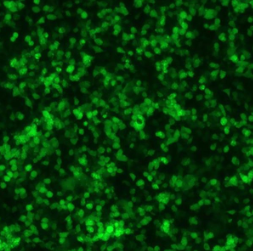 |
| Suspension | 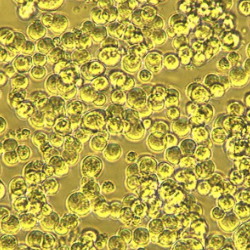 |
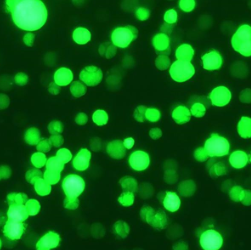 |
| Microcarrier (spinner) |
 |
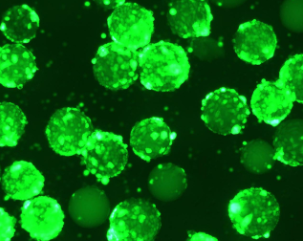 |
The AAV titers of cells and supernatants for all three cultures are presented in Figure 1 and Table 4.
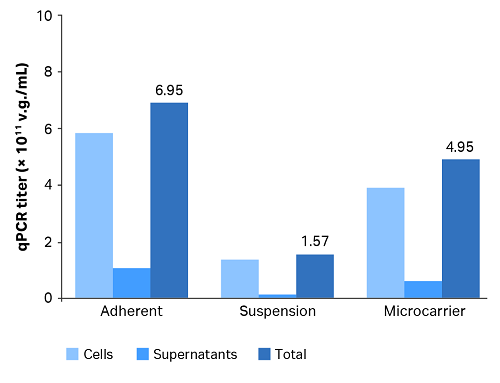
Fig 1. AAV production titers.
Table 4. AAV production titers
| Culture processes | qPCR titers(v.g./mL) | ||
| Cells | Supernatants | Total | |
| Adherent | 5.87 × 1011 | 1.08 × 1011 | 6.95 × 1011 |
| Suspension | 1.40 × 1011 | 1.67 × 1010 | 1.57 × 1011 |
| Microcarrier | 3.95 × 1011 | 6.44 × 1010 | 4.59 × 1011 |
The total titers for the microcarrier and adherent cultures were approximately 2.9- and 4.4-fold higher, respectively, than the total titer for the suspension culture.
The microcarrier culture process was confirmed by a 1 L bioreactor culture test. The key parameters and AAV titer curves are shown in Table 5 and Figure 2, respectively. As the culture time increased, the titer of the supernatant and cells also increased. The trend was more obvious in the curve for the cells, which was up to 3.3 × 1011 v.g./mL at 96 h and 4.5 × 1011 v.g./mL at 120 h (determined via qPCR).
Table 5. The microcarrier process in a 1 L bioreactor
| Stage of culture | Conditions | Parameters |
| Cell culture | Inoculum density (× 106 cells/mL) | 0.4 |
| Agitation (rpm) | 45 | |
| Culture volume (mL) | 400 | |
| Microcarrier concentration (g/L) | 3 | |
| Cell culture time (h) | 24 | |
| Transfection | Backbone:envelope:target:PEI (µg/mL) | 1:0.5:1:2 |
| Time to exchange medium after transfection (h) | 6–8 | |
| Harvest | Time to harvest (h) | 48, 72, 96, 120 |
| Harvest for supernatants or cells | Both |
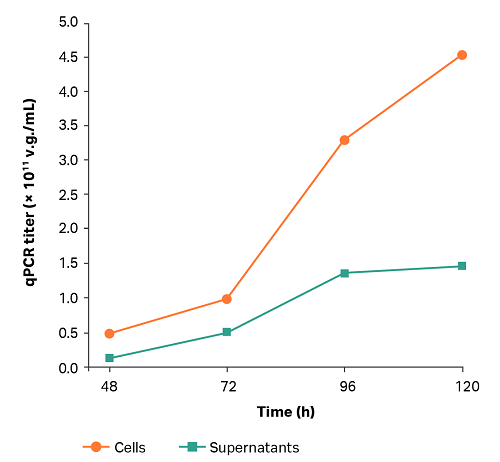
Fig 2. The AAV titer for a microcarrier process in a 1 L bioreactor.
Conclusions
These results demonstrate that a high AAV titer can be achieved on microcarriers in both a spinner flask and in a 1 L stirred-tank bioreactor. Further, the data suggest that the developed microcarrier process is suitable for large-scale AAV production.
Acknowledgements
We gratefully acknowledge Yongfa Lan, HaiRui Yang, and QingRui You from Obio Technology for permission to share their work.
References
- ClinicalTrials.gov database. NIH U.S. National Library of Medicine. https://www.clinicaltrials.gov/ct2/home. Accessed June 16, 2020.
- Yang J, Guertin P, Jia G, Lv Z, Yang H, Ju D. Large-scale microcarrier culture of HEK293T cells and Vero cells in single-use bioreactors. AMB Express. 2019;9(1). doi: 10.1186/s13568-019-0794-5. https://www.ncbi.nlm.nih.gov/pmc/articles/PMC6534633/
- Wang D, Tai PW, Gao G. Adeno-associated virus vector as a platform for gene therapy delivery. Nat Rev Drug Discov. 2019;18:358-378. doi: 10.1038/s41573-019-0012-9. https://www.nature.com/articles/s41573-019-0012-9
- Naso MF, Tomkowicz B, Perry WL, Strohl WR. Adeno-associated virus (AAV) as a vector for gene therapy. BioDrugs. 2017;31(4):317-334. doi: 10.1007/s40259-017-0234-5. https://www.ncbi.nlm.nih.gov/pmc/articles/PMC5548848/
- Chen XY, Chen JY, Tong XM, Mei JG, Chen YF, Mou XZ. Recent advances in the use of microcarriers for cell cultures and their ex vivo and in vivo application. Biotechnol Lett. 2020;42:1-10. doi: 10.1007/s10529-019-02738-7. https://pubmed.ncbi.nlm.nih.gov/31602549/
Learn about Cytiva solutions that support gene therapy applications.